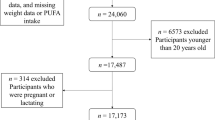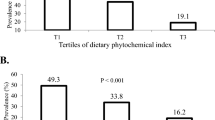Abstract
Evidence that intake of polyunsaturated fatty acids (PUFAs) may modify blood pressure (BP) is generally limited to middle-aged or hypertensive populations. This study examined cross-sectional associations between BP and dietary intake of PUFAs in 814 adolescents aged 13–15 years participating in the Western Australian Pregnancy Cohort (Raine) Study. Fatty acid intakes were assessed using 3-day diet records and resting BP was determined using multiple oscillometric readings. In multivariate regression models, systolic BP was inversely associated with intakes of polyunsaturated (b=−0.436, P<0.01), omega-3 (b=−2.47, P=0.02), omega-6 (b=−0.362, P=0.04) and long chain omega-3 fatty acids (b=−4.37, P=0.04) in boys. Diastolic BP and mean arterial pressure were inversely associated with intakes of long chain omega-3 fatty acids in boys (b=−3.93, P=0.01, b=−4.05, P=0.01, respectively). For specific long-chain omega-3s, significant inverse associations were observed between eicosapentaenoic acid (EPA) and docosahexaenoic acid, such as systolic BP decreasing by 4.7 mm Hg (95% CI –9.3 to −0.1) for a quarter gram increase in EPA, but no significant associations were observed with docosapentaenoic acid. No significant associations were observed in girls, or with the omega-6 to omega-3 ratio. Our results suggest that gender may moderate relationships between fatty acid intake and BP in adolescence.
This is a preview of subscription content, access via your institution
Access options
Subscribe to this journal
Receive 12 digital issues and online access to articles
$119.00 per year
only $9.92 per issue
Buy this article
- Purchase on Springer Link
- Instant access to full article PDF
Prices may be subject to local taxes which are calculated during checkout
Similar content being viewed by others
References
Ezzati M, Rodgers A, Lopez AD, Hoorn SV, Murray CJL . Mortality and burden of disease attributable to individual risk factors. In: Ezzati M, Lopez A, Rodgers A, Murray C (eds). Comparative Quantification of Health Risks Global and Regional Burden of Disease Attributable to Selected Major Risk Factors. Geneva World Health Organization, Geneva, Switzerland, 2004. pp 2141–2165.
Flynn JT . Hypertension in the young: epidemiology, sequelae and therapy. Nephrol Dial Transplant 2009; 24 (2): 370–375.
Luma GB, Spiotta RT . Hypertension in children and adolescents. Am Fam Physician 2006; 73: 1158–1168.
Hall WL . Dietary saturated and unsaturated fats as determinants of blood pressure and vascular function. Nutr Res Rev 2009; 22 (01): 18–38.
Mori TA, Burke V, Beilin LJ . Dietary fats and blood pressure. In: Lip G, Hall J (eds). Comprehensive Hypertension Section I: Epidemiology. Elsevier: Philadelphia, USA, 2007. pp 77–88.
Grynberg A . Hypertension prevention: from nutrients to (fortified) foods to dietary patterns. Focus on fatty acids. J Hum Hypertens 2005; 19 (S3): S25–S33.
Geleijnse JM, Giltay EJ, Grobbee DE, Donders ART, Kok FJ . Blood pressure response to fish oil supplementation: metaregression analysis of randomized trials. J Hypertens 2002; 20 (8): 1493–1499.
Simopoulos AP . The importance of the omega-6/omega-3 fatty acid ratio in cardiovascular disease and other chronic diseases. Exp Biol Med 2008; 233 (6): 674–688.
Mori TA, Watts GF, Burke V, Hilme E, Puddey IB, Beilin LJ . Differential effects of eicosapentaenoic acid and docosahexaenoic acid on vascular reactivity of the forearm microcirculation in hyperlipidemic, overweight men. Circulation 2000; 102 (11): 1264–1269.
Dyerberg J, Bang HO, Stoffersen E, Moncada S, Vane JR . Eicosapentaenoic acid and prevention of thrombosis and atherosclerosis? Lancet 1978; 2 (8081): 117–119.
Howe P, Meyer B, Record S, Baghurst K . Dietary intake of long-chain omega-3 polyunsaturated fatty acids: contribution of meat sources. Nutrition 2006; 22 (1): 47–53.
Tribole E . What happened to do no harm? The issue of dietary omega-6 fatty acids. Prostaglandins Leukot Essent Fatty Acids 2009; 80 (1): 78–79.
Simopoulos AP, Leaf A, Salem N . Workshop statement on the essentiality of and recommended dietary intake for omega-6 and omega-3 fatty acids. Leukot Essent Fatty Acids 2000; 63 (3): 119–121.
Harris WS, Mozaffarian D, Rimm E, Kris-Etherton P, Rudel LL, Appel LJ et al. Omega-6 fatty acids and risk for cardiovascular disease: a science advisory from the American Heart Association Nutrition Subcommittee of the Council on Nutrition, Physical Activity, and Metabolism; Council on Cardiovascular Nursing; and Council on Epidemiology and Prevention. Circulation 2009; 119 (6): 902–907.
Bocelli AMD, Ballo PMD . Hypertension in children and adolescents. Can Med Assoc J 2008; 179 (4): 343–344.
Ueshima H, Stamler J, Elliott P, Chan Q, Brown IJ, Carnethon MR et al. Food omega-3 fatty acid intake of individuals (total, linolenic acid, long-chain) and their blood pressure: INTERMAP Study. Hypertension 2007; 50 (2): 313–319.
Newnham JP, Evans SF, Michael CA, Stanley FJ, Landau LI . Effects of frequent ultrasound during pregnancy: a randomised controlled trial. Lancet 1993; 342: 887–891.
Crawford P, Obarzanek E, Morrison J . Comparative advantage of 3-day food records over 24-h recall and 5-day food frequency validated by observation of 9- and 10-year-old girls. J Am Diet Assoc 1994; 94 (6): 626–630.
Di Candilo KG, Oddy WH, Miller M, Sloan N, Kendall GE, de Klerk NH . Follow-up phone calls increase nutrient intake estimated by three-day food diaries in 13-year-old participants of the Raine study. Nutr Diet 2007; 64 (3): 165–171.
O’Sullivan TA, Ambrosini GL, Beilin LJ, Mori TA, Oddy WH . Dietary intake and food sources of fatty acids in Australian adolescents. Nutrition 2011; 27 (2): 153–159.
Mann NJ, Sinclair AJ, Percival P, Lewis JL, Meyer BJ, Howe PRC . Development of a database of fatty acids in Australian foods. Nutr Diet 2003; 60 (1): 42–45.
Food Standards Australia New Zealand. Nutrient Tables for use in Australia: Online Version. 2006 [cited May-July 2008]; Available from: http://www.foodstandards.gov.au/monitoringandsurveillance/nuttab2006/onlineversionintroduction/onlineversion.cfm.
Mori T, Burke V, Puddey I, Watts G, O’Neal D, Best J et al. Purified eicosapentaenoic acid and docosahexaenoic acid have differential effects on serum lipids and lipoproteins, LDL—particle size, glucose and insulin, in mildly hyperlipidaemic men. Am J Clin Nutr 2000; 71 (5): 1085–1094.
Tanner J . Growth at Adolescence: With a General Consideration of the Effects of Hereditary and Environmental Factors upon Growth and Maturation from Birth to Maturity. Blackwell Scientific: Oxford, England, 1962.
Duke PM, Litt IF, Gross RT . Adolescents’ self-assessment of sexual maturation. Pediatrics 1980; 66 (6): 918–920.
Willett W, Howe G, Kushi L . Adjustment for total energy intake in epidemiologic studies. Am J Clin Nutr 1997; 65 (4): 1220S–1228S.
Øverby NC, Serra-Majem L, Andersen LF . Dietary assessment methods on n-3 fatty acid intake: a systematic review. Br J Nutr 2009; 102 (SupplementS1): S56–S63.
Abeywardena MY, Head RJ . Longchain n-3 polyunsaturated fatty acids and blood vessel function. Cardiovasc Res 2001; 52 (3): 361–371.
Mori TA, Woodman RJ . The independent effects of eicosapentaenoic acid and docosahexaenoic acid on cardiovascular risk factors in humans. Curr Opin Clin Nutr Metab Care 2006; 9 (2): 95–104.
Terano T, Hirai A, Hamazaki T, Kobayashi S, Fujita T, Tamura Y et al. Effect of oral administration of highly purified eicosapentaenoic acid on platelet function, blood viscosity and red cell deformability in healthy human subjects. Atherosclerosis 1983; 46 (3): 321–331.
Margolin G, Huster G, Glueck CJ, Speirs J, Vandegrift J, Illig E et al. Blood pressure lowering in elderly subjects: a double-blind crossover study of omega-3 and omega-6 fatty acids. Am J Clin Nutr 1991; 53 (2): 562–572.
Paschos G, Magkos F, Panagiotakos D, Votteas V, Zampelas A . Dietary supplementation with flaxseed oil lowers blood pressure in dyslipidaemic patients. Eur J Clin Nutr 2007; 61 (10): 1201.
Grimsgaard S, Bonaa KH, Jacobsen BK, Bjerve KS . Plasma saturated and linoleic fatty acids are independently associated with blood pressure. Hypertension 1999; 34 (3): 478–483.
Wilson PWF, D’Agostino RB, Levy D, Belanger AM, Silbershatz H, Kannel WB . Prediction of coronary heart disease using risk factor categories. Circulation 1998; 97 (18): 1837–1847.
Chae CU, Lee RT, Rifai N, Ridker PM . Blood pressure and inflammation in apparently healthy men. Hypertension 2001; 38 (3): 399–403.
Blair IA, Prakash C, Phillips MA, Dougherty RM, Iacono JM . Dietary modification of omega 6 fatty acid intake and its effect on urinary eicosanoid excretion. Am J Clin Nutr 1993; 57 (2): 154–160.
Vergroesen AJ, Fleischman AI, Comberg H-U . The influence of increased dietary linoleate on essential hypertension in man. Acta Biol Med Ger 1978; 37: 879–883.
Clifton P . Dietary fatty acids and inflammation. Nutr Diet 2009; 66 (1): 7–11.
De Caterina R, Liao J, Libby P . Fatty acid modulation of endothelial activation. Am J Clin Nutr 2000; 71: 213S–223S.
Pischon T, Hankinson S, Hotamisligil G, Rifai N, Willett W, Rimm E . Habitual dietary intake of n-3 and n-6 fatty acids in relation to inflammatory markers among US men and women. Circulation 2003; 108: 155–160.
Burdge G . Alpha-linolenic acid metabolism in men and women: nutritional and biological implications. Curr Opin Clin Nutr Metab Care 2004; 7 (2): 137–144.
Orshal JM, Khalil RA . Gender, sex hormones, and vascular tone. Am J Physiol Regul Integr Comp Physiol 2004; 286 (2): R233–R249.
Farhat MY, Lavigne MC, Ramwell PW . The vascular protective effects of estrogen. FASEB J 1996; 10 (5): 615–624.
Knorr D, Bidlingmaier F, Butenandt O, Fendel H . Plasma testosterone in male puberty. I. Physiology of plasma testosterone. Acta Endocrinol (Copenh) 1974; 75 (1): 181–194.
Rapkin AJ, Tsao JCI, Turk N, Anderson M, Zeltzer LK . Relationships among self-rated tanner staging, hormones, and psychosocial factors in healthy female adolescents. J Pediatr Adolesc Gynecol 2006; 19 (3): 181–187.
Ayer JG, Harmer JA, Xuan W, Toelle B, Webb K, Almqvist C et al. Dietary supplementation with n-3 polyunsaturated fatty acids in early childhood: effects on blood pressure and arterial structure and function at age 8 y. Am J Clin Nutr 2009; 90 (2): 438–446.
Goyens PLL, Spilker ME, Zock PL, Katan MB, Mensink RP . Conversion of α-linolenic acid in humans is influenced by the absolute amounts of α-linolenic acid and linoleic acid in the diet and not by their ratio. Am J Clin Nutr 2006; 84 (1): 44–53.
Rose G . Strategy of prevention: lessons from cardiovascular disease. Br Med J 1981; 282 (6279): 1847–1851.
Chen X, Wang Y . Tracking of blood pressure from childhood to adulthood: a systematic review and meta-regression analysis. Circulation 2008; 117 (25): 3171–3180.
McCarron P, Smith GD, Okasha M, McEwen J . Blood pressure in young adulthood and mortality from cardiovascular disease. Lancet 2000; 355 (9213): 1430–1431.
Xyris Software. Foodworks with RMIT Australian Fatty Acids: Fatty acid database compiled by the RMIT Lipid Research Group, Foodworks 5 Service Pack 1 (Build 1376). Brisbane, Queensland, 2007.
Acknowledgements
We would like to express our gratitude to all the families who took part in this study and the Raine Study team, which includes data collectors, cohort managers, data managers, clerical staff, research scientists and volunteers. Thanks also goes to Xyris Software, Brisbane. We acknowledge the support of the Telethon Institute for Child Health Research and Royal Perth Hospital laboratories. Sources of funding: The Western Australian Pregnancy Cohort (Raine) Study is funded by the Raine Medical Research Foundation at The University of Western Australia, the National Health and Medical Research Council of Australia, the Telstra Research Foundation, the Western Australian Health Promotion Foundation, the Australian Rotary Health Research Fund and the National Heart Foundation of Australia and Beyond Blue.
Author information
Authors and Affiliations
Corresponding author
Ethics declarations
Competing interests
The authors declare no conflict of interest.
Rights and permissions
About this article
Cite this article
O'Sullivan, T., Bremner, A., Beilin, L. et al. Polyunsaturated fatty acid intake and blood pressure in adolescents. J Hum Hypertens 26, 178–187 (2012). https://doi.org/10.1038/jhh.2011.7
Received:
Revised:
Accepted:
Published:
Issue Date:
DOI: https://doi.org/10.1038/jhh.2011.7
Keywords
This article is cited by
-
Association between dietary intake of polyunsaturated fatty acid and prevalence of hypertension in U.S. adults: A cross-sectional study using data from NHANES 2009–2016
Hypertension Research (2022)
-
A Western dietary pattern is associated with higher blood pressure in Iranian adolescents
European Journal of Nutrition (2017)
-
Serum long-chain omega-3 polyunsaturated fatty acids and risk of orthostatic hypotension
Hypertension Research (2016)



